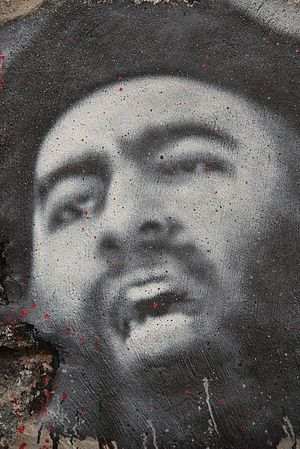The turf war between the Taliban and the Islamic State may be intensifying in Afghanistan. On Monday, masked gunmen claiming to fight for the Islamic State of Iraq and Syria (ISIS, or IS) killed Abdul Ghani, a Taliban commander, in Logar province. The incident was reported by Afghanistan’s Pajhwok News based on the testimony of the administrative chief for Charkh district in Logar. After killing the Taliban commander, the militants ordered civilians and bystanders to refrain from watching television. The attack took place during the daytime in the main district bazaar.
According to the district chief’s testimony, the gunmen were dressed in black and claimed that they were soldiers of the Islamic State. Since its rise to prominence last summer in Iraq, Abu Bakr al-Baghdadi, the leader of the Islamic State, declared the creation of a caliphate spanning Iraq and Syria and set himself up as the caliph. The Islamic State has spent considerable energy since then in recruiting would-be jihadists in Pakistan and Afghanistan to its cause. The incident in Logar province could simply be the result of a local flare-up. Alternatively, it could foreshadow broader conflict between the Islamic State and the Afghan Taliban. The Islamic State’s presence in Afghanistan should not be overstated by any means; the Taliban remain the stronger militant outfit by far. The Islamic State’s popularity is growing, but it lacks a well-institutionalized presence in Afghanistan.
Evidence of an Islamic State presence in Afghanistan isn’t entirely absent. In a separate Pajhwok report, Mohammad Omar Safi, the governor of the northeastern region of Kunduz province, said that about 70 IS-affiliated militants were operating in the province. Safi cautioned that the Afghan government needed to develop a strategy to combat the Islamic State’s growing influence within his province. In Helmand province, around 300 IS-affiliated militants are being led by Mullah Abdul Rauf Khadim, a former Taliban commander. Khadim was reportedly captured with around 45 supporters just under a week ago by the Afghan Taliban for “anti-Islamic activities.” As U.S. troops leave Afghanistan, the primary objective of the Afghan National Army is neutralizing the threat from the Taliban and affiliated militant groups. Islamic State-affiliated militants could considerably complicate the Afghan government’s efforts to improve the country’s security situation.
Recently, the Islamic State declared the creation of the Khorasan Shura — a leadership council for Afghanistan and Pakistan composed almost entirely of former Tehreek-e-Taliban Pakistan (TTP) leaders. The announcement of the Shura demonstrated that the group’s ambitions for influence among jihadists in Pakistan and Afghanistan will continue to grow. While fighters with the Pakistani Taliban have defected to the Islamic State, following in the footsteps of the members of the Khorasan Shura, the Afghan Taliban have remained loyal to Mullah Omar and have refused to declare their loyalty to Abu Bakr al-Bahgdadi in most cases.
The success of the Taliban in Afghanistan and Pakistan is a major impediment to the Islamic State’s mission to successfully pitch its caliphate as the only viable destination for jihadists worldwide. The Pakistani and Afghan Taliban control and exercise authority over large amounts of territory, undermining the Islamic State’s efforts at being seen as the only sustainable radical Sunni-Salafi domain. For the moment, there is little reason to believe that the Islamic State will abandon its recruitment efforts in Afghanistan and Pakistan. The turf war between the Islamic State and the Taliban may have just begun.
































